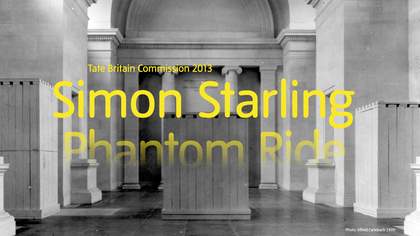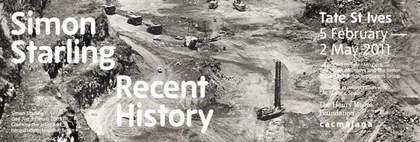The following illustrated texts flag up a number of works from the last ten years, some of which are still in production, that take as their starting point existing objects or artworks and deploy processes of reproduction or replication as an investigative tool. All of these projects engage (to a greater or lesser extent) in, and have been generated through a close collaboration with, the mechanisms and culture of the museum.
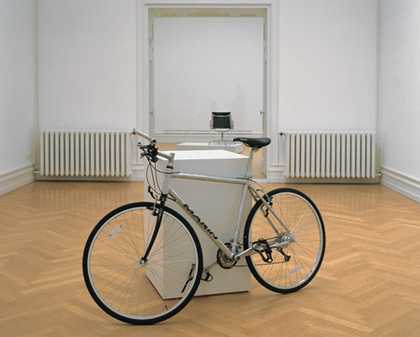
Fig.1
Simon Starling
A Charles Eames ‘Aluminium Group’ chair remade using the metal from a ‘Marin Sausalito’ bicycle / A ‘Marin Sausalito’ bicycle remade using the metal from a Charles Eames ‘Aluminium Group’ chair 1997
Bicycle, chair, two plinths, glass, vinyl text
Installation view, Kunsthalle Bern
© Simon Starling
Work, Made-ready, Kunsthalle Bern
Work, Made-ready, Kunsthalle Bern 1997 (Fig.1) inverts the notion of the readymade in a simple but labour-intensive act of transmutation. Two aluminium objects were reconstructed using the metal from the other. What resulted were two handcrafted, degraded, mutations of their former manufactured selves, scarred from their genetic transfer and separated by a sheet of glass that supported a recto/verso text, a recipe for the work.
Nachbau
The Museum Folkwang was founded by Karl Ernst Osthaus in Hagen in 1902 and was one of the first museums of its kind. After his early death in 1921 large parts of his collection were moved to Essen. From 1929 they were exhibited in the new Museum Folkwang in Essen, which comprised two existing buildings, the Goldschmidt Villas, as well as a significant extension by the architect Eduard Körner on the Folkwang’s present site. In 1944–5 both the Villas and Körner’s building were destroyed by bombing.
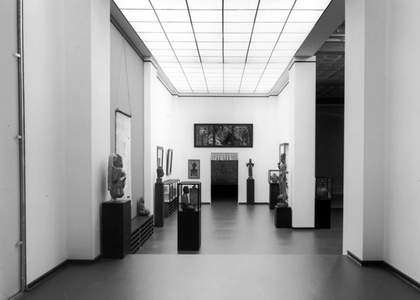
Fig.2
Simon Starling
Nachbau
Installation view 2007
Courtesy Museum Folrwang, Essen © Simon Starling
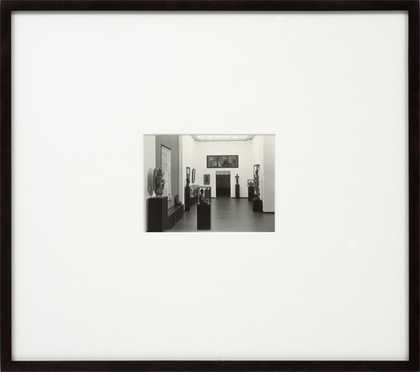
Fig.3
Simon Starling
Nachbau 2007
Courtesy Museum Folrwang, Essen © Simon Starling
The photographer Albert Renger-Patzsch (1897–1966) worked in and for the Museum Folkwang for a number of years before the outbreak of the World War II. Best known for his work documenting the industrialisation of the Ruhr in the 1920s and 1930s and for his book Die Welt ist Schön (The World is Beautiful) 1928,1 Renger-Patzsch was given a studio at the Folkwang in return for his occasonal work as museum photographer. For almost ten years he regularly photographed objects from the collection as well as documenting the various installations within the museum. Since Renger-Patzsch never signed a contract formalising this arrangement, the largely unknown body of work made for the museum is now under the control of the owners of his estate. Nachbau (Reconstruction), 2007 conceived in relation to the impending demolition of the newest part of one of the oldest modern art museums in Europe, was developed as a partial corrective to this situation and involved the rebuilding of a part of the 1930s Museum Folkwang and the subsequent re-installation of the 1930s period hang.
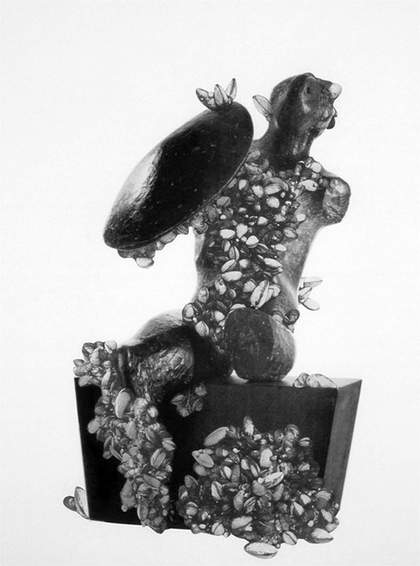
Fig.4
Simon Starling
Infestation Piece
Proposal for Lake Ontario, 2006
This work is on show at The Power Plant in Toronto in February 2008
Courtesy The Modern Institute, Glasgow © Simon Starling
The ‘stage set’, which eventually facilitated the ‘remaking’ of Renger-Patzsch’s images, was built in large part by stripping out and reconfiguring the mobile wall system in the museum’s so-called Neubau (New Building), for which this exhibition was the last. Nachbau also involved the ‘faking’ of a number of works from the collection that had been confiscated under National Socialism – a Giorgio de Chirico now in Switzerland, a Franz Marc and a Erich Heckel both in the US. Apart from some speculative use of colour and a single missing sculpture, the reconstruction was exact in every detail, even, it was observed, down to its smell. What will remain of Nachbau, once the Neubau is demolished to make way for a building designed by David Chipperfield Architects, are about 16 seconds of diffused light captured, as if in a rare moment of reverse time travel, on fourets of film some sixty-five years after Renger-Patzsch himself clutched at his cable release and gazed into the ‘ineffably luminous eyes’2 of Paula Modersohn-Becker’s Self Portrait 1906.
Infestation Piece (Work in Progress)
This ongoing work commissioned by The Power Plant, Toronto, conflates two stories of inundation and domination. The first involves the dominant role played by Henry Moore in the development of late-modernism in the city of Toronto, the realisation of a number of ambitious public sculptures in the city and his eventual donation of a large number of key works to the city. The second story is that of a small mollusc accidentally introduced into the Great Lakes in the late 1980s by cargo ships from their original habitats around the Black Sea. The Zebra mussel has proved extremely successful in its new environment and has radically altered the ecosystem of the Great Lakes and beyond. Following extended negotiations with the Henry Moore Foundation a sculpture ‘based on’ Moore’s 1954 sculpture Warrior with a Shield, a sculpture that evolved from a stone Moore found on the beach in England, was produced in steel (bronze being toxic to mussels), and then thrown into Lake Ontario, where, for the past year and a half, it has played host to a thriving colony of Zebra mussels.
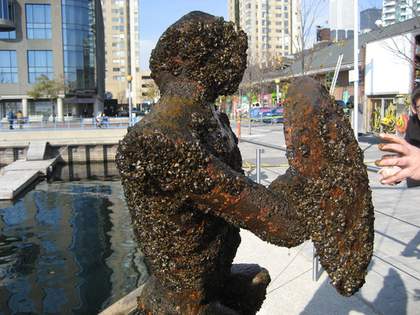
Fig.5
Simon Starling
Infestation Piece
Proposal for Lake Ontario, 2006
This work is on show at The Power Plant in Toronto in February 2008
Courtesy The Modern Institute, Glasgow © Simon Starling
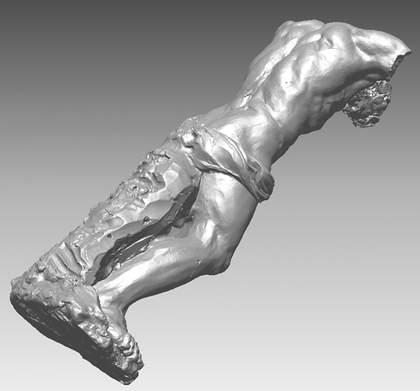
Fig.5
Simon Starling
Drop Sculpture (Work in Progress)
© Simon Starling
Drop Sculpture (Atlas), A Project for the New Conservation Department, Rijksmuseum, Amsterdam
Taking as a starting point the terracotta sculpture of the mythological figure Atlas made by Artus Quellinus as a model for a decorative figure that can today be seen on the exterior of the New Town Hall (1648), Drop Sculpture (Atlas) which has been developed for and with the Conservation Department at the Rijksmuseum, Amsterdam, deploys both the architecture of the departments new building and use of that space as generative factors in determining its form. The work has evolved in close collaboration with the people who will pass it everyday.
The choice of Quellinus’s Atlas figure is simple and playful, and relates directly to his mythological role as the carrier of the weight of the world or supporter of the heavens – and it is gravity that will be the chief architect of this project. The figure was also chosen for its base materials (terracotta) and appropriate size (75 cm high). Three terracotta replicas of the Quellinus original have been produced using industrially developed laser scanning technology and 3D printing, transforming Atlas momentarily into a stream of numbers. The resulting copies, on which the sculptor’s fingerprints are still clearly visible, will be dropped from various heights, repaired and then displayed in the lobby of the Conservation Department at the height from which they were dropped.
The project for the Rijksmuseum picks up on ideas developed in many previous works. Works that have similarly involved collaboration (for example, CMYK, RGB – the production of a catalogue that documented its own making in a print works in Romania) attempted to reverse entropic trajectories (Pleçnik, Union – the rebuilding of a glass lamp and the beer bottle used to smash it) or have deployed existing sculptures in new roles and relationships (Bird in Space 2006: the importation of a massive slab of Romanian steel as an art work during the steel import tax controversy in the US). All of these ideas and methodologies appear in this raw new work.
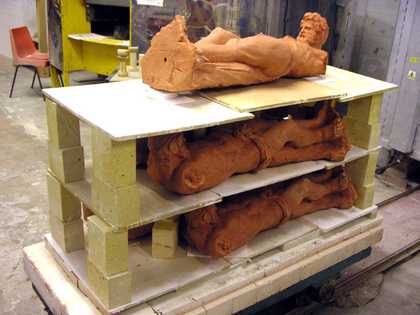
Fig.6
Simon Starling
Drop Sculpture (Work in Progress)
Courtesy The Rijksmuseum, Amsterdam © Simon Starling
Just as the film Robert Smithson made to document Glue Pour, his ode to entropy, cites Humpty Dumpty as a key influence, Drop Sculpture (Atlas) sets itself up as a counter-entropic work, and, as such, as a celebration of the conservator’s art.

